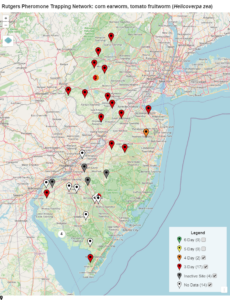Sweet Corn
Fall armyworm (FAW) infestations have increased again, as per reports from south Jersey. It seems as though there was an increase in adult numbers with warm weather last week, concurrent with an increase in corn earworm (see below) . Re-infestations following treatment can and have occurred. Because FAW moths are highly mobile, it is important to monitor fields at least weekly for signs of infestation. Whorl, and even seedling stage plants are prime targets for egg laying. Delays in treating whorl stage infestations can lead to stunted plants and poor ear size.
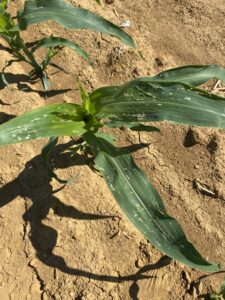 Newly hatched FAW larvae cause holes and scratches on leaves that are similar to ECB feeding, except that they tend to be more concentrated and always lead down into the whorl (see photo at upper left). As the larvae grow, the feeding becomes more destructive, with large ragged holes and obvious droppings deposited in the whorl (see photo at right).
Newly hatched FAW larvae cause holes and scratches on leaves that are similar to ECB feeding, except that they tend to be more concentrated and always lead down into the whorl (see photo at upper left). As the larvae grow, the feeding becomes more destructive, with large ragged holes and obvious droppings deposited in the whorl (see photo at right). 
We will provide updates on new FAW appearances and severity as reports come in. FAW are resistant to synthetic pyrethroids. Effective sprays should include IRAC grp. 5 (spinosyns) or IRAC grp. 28 (diamides). The carbamate (IRAC grp. 1A) Lannate is also still effective. Sufficient water should be used 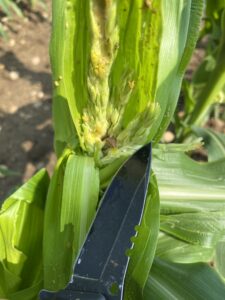 in the applications to allow the solution to reach larvae that are partially protected while feeding on the immature tassel (photo at lower left), and to penetrate the layer of droppings that may have formed above the caterpillars.
in the applications to allow the solution to reach larvae that are partially protected while feeding on the immature tassel (photo at lower left), and to penetrate the layer of droppings that may have formed above the caterpillars.
Corn earworm (CEW) moth captures from northern and central blacklight traps increased dramatically late last week. Pheromone trap information is available from all northern and central sites, but is limited from southern New Jersey. Overall, pheromone catches jumped, with continued very high numbers in the Woodstown (Salem) (see pheromone trap map below). With little information from South Jersey, growers there would be wise to assume numbers at least as high as those represented in the central and northern traps. Numbers have shown signs of decline since the cold front over the weekend, but the threat remains. We will use a combination of pheromone and blacklight trap types to derive silk spray schedules by region. Silking corn is at risk of CEW infestation at this time. Be sure to access information from this publication in the upcoming weeks to determine how frequently you should treat silking sweet corn to protect it from CEW infestation.
The highest nightly blacklight trap catches of CEW for the week ending 9/04/24 are as follows:
| Bellemeade 25 | Hackettstown 11 | Denville 7 | Farmingdale 6 |
| Georgetown 15 | Princeton 9 | Lawrenceville 7 | Milltown 5 |
| Pennington 15 | Hillsborough 8 | Allamuchy 6 | Sergeantsville 5 |
The highest nightly pheromone trap catches of CEW for the week ending 9/04/24 are as follows:
| Woodstown 181 | Califon 57 | Snyder Farm (Hunterdon) 45 |
| New Egypt 109 | Green Creek 56 | Chester 42 |
| Milford 83 | South Branch 52 | Hackettstown 41 |
| Georgetown 73 | Matawan 49 | Sparta 36 |
Thanks to Joe LaForest of Univ. of GA, and the Southern IPM Center for producing maps from our NJ CEW data!
Using our current pheromone- based thresholds (30″ Hartstack trap) developed by the Univ. of Delaware, nightly corn earworm moth catches translate to:
0 moths – 6-7 day spray schedule
1 moth – 5 day spray schedule
2-20 moths – 4 day spray schedule
>20 moths – 3 day spray schedule
Silking Spray Schedules*:
South – 3 days
Central – 3 days
North – 3 days
*These recommendations are based on regional catches. Adhere to tighter spray schedules if indicated by local trap catches. Synthetic pyrethroids alone should NOT be used for corn earworm (CEW) protection on silking corn, or for fall armyworm (FAW) management at any stage. Control with these materials is very inconsistent.
Beet Armyworm
Beet armyworm (BAW) numbers in pheromone traps in the Woodstown area of Salem County have gotten extremely high over the past week. Thanks to a grower cooperator in that area, we know that catches range from 268 to 299/night over the past week in local traps. This pest can cause significant injury on peppers as well as leafy greens like swiss chard, and kale. Larvae are beginning to appear as far north as Hunterd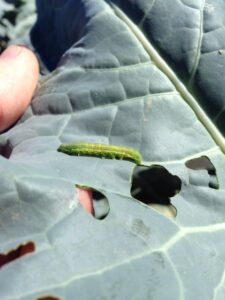 on County, although it is likely that serious infestations are or will occur in southern NJ now. Monitor pepper fields weekly for signs of feeding. BAW larvae (photo at left) feed in the developing foliage in terminal growth of pepper plants. Initially, leaves are skeletonized, but as larvae grow, they will move onto fruit and damage these as well. In northern NJ, BAW is an occasional, and typically low level pest of cole crops. Infestations tend to be very local for unknown reasons. As with other armyworms, BAW is difficult to control with pyrethroid insecticides. Effective materials include spinosyns (IRAC 5) and diamides (IRAC 28).
on County, although it is likely that serious infestations are or will occur in southern NJ now. Monitor pepper fields weekly for signs of feeding. BAW larvae (photo at left) feed in the developing foliage in terminal growth of pepper plants. Initially, leaves are skeletonized, but as larvae grow, they will move onto fruit and damage these as well. In northern NJ, BAW is an occasional, and typically low level pest of cole crops. Infestations tend to be very local for unknown reasons. As with other armyworms, BAW is difficult to control with pyrethroid insecticides. Effective materials include spinosyns (IRAC 5) and diamides (IRAC 28).
Cucurbit Crops
Cucurbit downy mildew (CDM) is active on many cucurbit crops throughout NJ now. Look for chlorotic areas bordered by veins on the upper leaf surface (photo at lower right). If conditions are moist, dark sporulation may be found on the lower leaf surface (photo at lower left). CDM has been identified on winter squash in northern NJ as of 8/18/24 (see CDM update) and on pumpkin and summer squash in southern NJ as of 8/21/24 as Dr. Andy Wyenandt reports today. Recent scouting reports from northern fields indicate that control has been good with recommended fungicides.
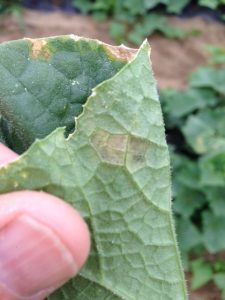
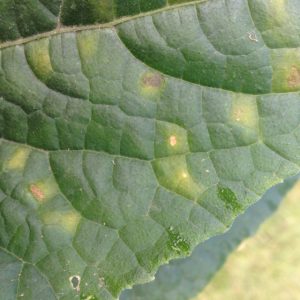 All cucurbit plantings should be protected now. Useful materials for CDM may be found in the Cucumber Section of the 2024/25 Commercial Vegetable Production Recommendations.
All cucurbit plantings should be protected now. Useful materials for CDM may be found in the Cucumber Section of the 2024/25 Commercial Vegetable Production Recommendations.
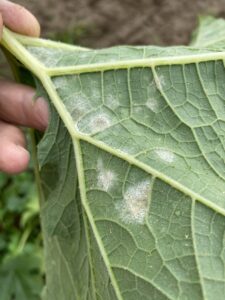 Powdery mildew (PM) thresholds (2 infected leaves/50 leaf sample) have been exceeded in all fields. Once PM lesions (photo at right) begin to appear, the protectant fungicide program for this disease should be initiated. The program generally includes a combination of broad spectrum protectants and more targeted, locally systemic fungicides. For a complete list of suggested materials, see the Pumpkin and Winter Squash Section of the 2024/25 Commercial Vegetable Production Recommendations. Ideally, a fungicide program should include a rotation of 3 different FRAC code materials combined with broad spectrum protectants in each application.
Powdery mildew (PM) thresholds (2 infected leaves/50 leaf sample) have been exceeded in all fields. Once PM lesions (photo at right) begin to appear, the protectant fungicide program for this disease should be initiated. The program generally includes a combination of broad spectrum protectants and more targeted, locally systemic fungicides. For a complete list of suggested materials, see the Pumpkin and Winter Squash Section of the 2024/25 Commercial Vegetable Production Recommendations. Ideally, a fungicide program should include a rotation of 3 different FRAC code materials combined with broad spectrum protectants in each application.
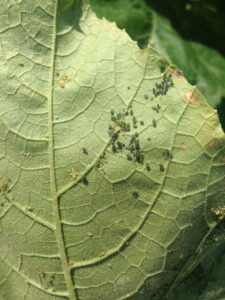 Melon aphids (photo at left) are now appearing in some fields of winter squash and pumpkins. While not doing much damage to plants overall, these colonies can get quite large, and will deposit their sticky droppings on fruit below. This, in turn, supports the growth of sooty mold, and makes the fruit unsightly. Further, the sticky droppings attract hornets, which can be an issue for harvesting crews or U-pickers. Should melon aphid colonies appear in three or more sites in a ten site sample, consider applying an aphid specific material for control. There are multiple options in the Pumpkin and Winter Squash section of the Commercial Vegetable Recommendations that have low toxicity to bees.
Melon aphids (photo at left) are now appearing in some fields of winter squash and pumpkins. While not doing much damage to plants overall, these colonies can get quite large, and will deposit their sticky droppings on fruit below. This, in turn, supports the growth of sooty mold, and makes the fruit unsightly. Further, the sticky droppings attract hornets, which can be an issue for harvesting crews or U-pickers. Should melon aphid colonies appear in three or more sites in a ten site sample, consider applying an aphid specific material for control. There are multiple options in the Pumpkin and Winter Squash section of the Commercial Vegetable Recommendations that have low toxicity to bees.
Corn Earworm Traps – 30″ Hartstack type
Growers wishing to purchase corn earworm pheromone traps to conduct their own on-farm monitoring should contact:
Mike “O” Olsowski
3510 Sutton Rd.
Geneva, NY 14456
Phone: 315-651-5929
Mike O manufactures these 30″ Hartstack traps in his shop. These traps are the same as the ones we use currently in the IPM Program, and spray thresholds are based on this type.
Lures currently used in the Rutgers Vegetable IPM Program corn earworm pheromone traps are:
Hercon Luretape, available from Great Lakes IPM
Lures are placed in the clip at the base of the large cone, and a new one is added at two week intervals.
Thank you!
The Vegetable IPM Program wishes to thank the following Field Technicians, without whom much of the information presented weekly here would not be available:
Chris Cloutier
Hamna Khalid
Alexandra Suszko
Best wishes for those returning to Rutgers for the Fall semester!
